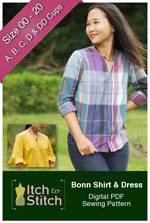digital carey top sewing pattern
The Carey Top is easy to style and comfy to wear. Use a wild print and make it part of your fashionista ensemble. Or use a sheer fabric and make a swimsuit cover-up.
-
Itch to Stitch Digital Patterns
This style is provided as a digital pattern. It may be printed on home printers that use either 8 1/2" x 11" or A4 paper or at a print shop that can print A0-sized pattern sheets. When you complete your order, you will be provided with a unique code to instantly download the pattern. See our digital product policy for full details.
All Itch to Stitch patterns come as multiple PDF files consolidated within a single .zip file. Download and save the .zip file to a computer to access the PDF files. Downloading .zip files to mobile devices is not recommended as most phones and tablets cannot open them.
Description
Carey Top is easy to style and comfy to wear. Use a wild print and make it part of your fashionista ensemble. Or use a sheer fabric and make a swimsuit cover-up.
Carey Top features:
- Elbow-length drawstring-gathered dolman sleeves
- Contrast shoulder panels
- Round neckline
- High/low shirttail hem
- Lengthen/shorten lines and instructions provided – can be lengthened to tunic or dress length
- Layers feature–print only the sizes you need
Suggested Fabrics
Primary fabric: Use a very light-weight soft woven fabric or knit fabric with drape. Rayon challis, voile, batiste, georgette, charmeuse and jersey are great choices. Do not use quilting cotton or heavier weight fabrics. Contrast Fabric: A contrast fabric is used for the shoulder panels. You could use the same fabric as the primary fabric, or use a similar quality light-weight woven fabric. Rayon challis, voile, batiste, georgette, charmeuse and jersey are great choices. You could use a semi-transparent fabric to add interest.
Notions
- 3.5 yards (320 cm) of purchased 1/4" (0.6 cm) ribbon, twill tape or cording can be used as drawstrings instead of making your own
Size Chart, Finished Measurements, and Fabric Requirements
Click to enlarge the final images at above right.
Choosing your Size
- Compare your waist circumference (narrowest part) to the “Body Measurements” table. Choose the size that fits your waist best. If you are between sizes, choose the smaller size if you like your garment more fitted; otherwise, choose the bigger size.
- Compare your fullest hip measurements to the “Body Measurements” table. Choose the size that fits your hip best. If you are between sizes, choose the smaller size if you like your garment more fitted; otherwise, choose the bigger size.
- It’s OK to use different sizes for the waist and hip. All you have to do is print the sizes that you need (see “Printing Instructions” and “Blend Sizes” in the instructions), and blend the lines from one size to the next from the waist to the hip.
- The bust measurement is not used to determine your size. For this design, the bust area is integrated into the sleeve and therefore is not a defined area.
- It is highly recommended that you check your fit by making a test garment with inexpensive fabrics that have similar weight as your final garment fabrics.
-
Be the first to review this item.














